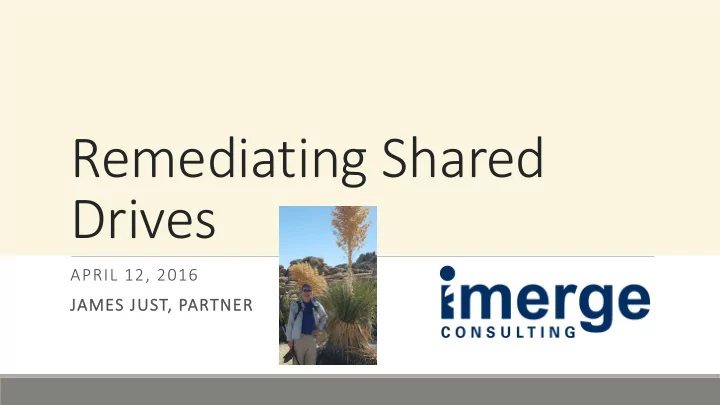

Remediating Shared Drives APRIL 12, 2016 JA JAMES J S JUST ST, P PARTNE TNER
Why Remediate Shared Drives? Reduce Costs: never delete? Server costs increase logarithmically. 7 4/12/2016
7. Business Document Assessment Business Documents Group (MS, PDF, Other & Email) Number of Files (added or modified 2,000,000 2,500.0 1,800,000 1,600,000 2,000.0 1,400,000 annually) 1,200,000 1,500.0 Space (GB) 1,000,000 800,000 1,000.0 600,000 400,000 500.0 200,000 - - 2000 2002 2004 2006 2008 2010 2012 2014 Files Space (GB) Linear (Files) Linear (Space (GB)) When valued at one labor hour per document, the 10,389,381 documents represent $623.4 million dollars of information assets growing at $77.0 million annually. Note: Information value calculated using the average Department-wide loaded labor rate of $60 per hour obtained from the Office of Finance to manage (includes create, update, publish, store, search, re-create, re-use of previous versions, etc.) the files. 9 4/12/2016
Why Remediate Shared Drives? Efficient retrieval of information ◦ eliminate clutter ◦ structure content logically (or move to ECM/SharePoint) ◦ appropriate tagging results in information findability Encouraging information sharing: properly organized shared drives (or use of ECM/SharePoint) simplifies security and sharing of information across the organization. Reducing redundancy and versions – ◦ reduces the risk of using wrong version for business decisions. ◦ improved information sharing reduces duplication (typically 30 to 50%) 10 4/12/2016
11 4/12/2016
Manual remediation
Basic Analysis Workflow Rules Redundant Outdate Certain ROT Trivial Classify and Sensitive Content Likely ROT Group Remaining Content (quarantine)
Clear out the easy ROT first Shouldn’t be on shares • Personal content (policy) • Wedding and vacation photos/videos • Music libraries • What have you seen?
Clear out the easy ROT first Likely junk • Temp files, Thumbs DB, or system generated files • Sort share by file type • Look for EXE, TXT, MPG, EPS, ILL, DAT, ZIP, etc. that don’t belong
Clear out the easy ROT first Orphan content • Personal subject folders (the digital equivalent of desk drawers ) 2005 • Check activity on shares • Separated staff more than RRS longest rule • Consider keystone status • Make share read only
Clear out the easy ROT first Redundancies • Earlier versions • Duplicates • PDF and Word • “copy of” • Scans not needed
Clear out the easy ROT first Options for ROT Disposition • Delete outright based on approved disposition rules • Make Folder “read only” and limit access to manager. No activity in a year, delete. • Move content to quarantine; leave stub to “contact manager”. • Formal approval for deletion. • Print everything and file in binders.
What’s wrong with this picture?
Second pass remediation Case and project files Folder names where date information exceeds retention Other obvious content assessment triggers • Authors • Date accessed • Date Modified • Date Created • Status flags
Migrate Create classification scheme/taxonomy • ISO1549 • Departmental • One retention rule for a folder structure • Differentiate drafts and final versions • Security – promote sharing, eliminate duplicates • Standardize metadata (folder and file names) Build new structure • Migrate old folder structure to new, “clean” • Or migrate to ECM/SharePoint • Or, build new structure and make old “read only”
Migrate Metadata available in folder and file names • Example: Contracts • Folder Name: 12345 Smith Cleaning Contract 2014-01-01 • File Name: 12345 Contract 2014-01-01 • File Name: 12345 Contract Attachment A 2014-01-01 • File Name: 12345 Addendum 1 2014-04-15 ECM/SharePoint Migration rules • Extract Contract number 12345 from Folder Name • Validate against contract tracking Access database • Pull party names from Access • Extract document type from File Name • Extract document date from File Name
Defined taxonomy
Analysis Gotchyas Backup/restore software can reset dates Long path names (SharePoint, OneDrive issue, ECM issue) Embedded links Business systems point to directories Security rules
Autoclassification and Shared Drive Remediation Software
How FACR Software Works • Like content • ECM • Workflow • Business • SharePoint • Dir start Ingest Group Verify Migrate rules • Human • New File • All files review Share • Confidence • Delete % Quarant antine ne Queue f for r bus. S s. SME Prepr eprocess Train aining doc’ c’t sets Chan ange r rig ights Queu eue f e for Leg egal OC OCR Sema emantic R Rel elations Se Security Photos Dir irect t to Mig igrate Visual al/grap aphical al classification ma match Link t to d datab abas ases Le Legal h l hold ld Regular e expressio ion Ma Mass a assign classification Searc rch con content f for or PII, e I, etc. Dup uplicate h hand ndling Du Dupl plicates 28 4/12/2016
FACR Software OU OUTPU PUT E EXAMPL PLES
Exact Match duplication analysis Hash value + Metadata
Migration Actions
Thank you! Jim Just james.just@imergeconsult.com Twitter: @JamesJust10 Phone: 608.239.8282
Recommend
More recommend